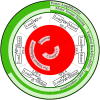An Overview on Principles for Energy Efficient Robot Locomotion
- PMID: 33501007
- PMCID: PMC7805619
- DOI: 10.3389/frobt.2018.00129
An Overview on Principles for Energy Efficient Robot Locomotion
Abstract
Despite enhancements in the development of robotic systems, the energy economy of today's robots lags far behind that of biological systems. This is in particular critical for untethered legged robot locomotion. To elucidate the current stage of energy efficiency in legged robotic systems, this paper provides an overview on recent advancements in development of such platforms. The covered different perspectives include actuation, leg structure, control and locomotion principles. We review various robotic actuators exploiting compliance in series and in parallel with the drive-train to permit energy recycling during locomotion. We discuss the importance of limb segmentation under efficiency aspects and with respect to design, dynamics analysis and control of legged robots. This paper also reviews a number of control approaches allowing for energy efficient locomotion of robots by exploiting the natural dynamics of the system, and by utilizing optimal control approaches targeting locomotion expenditure. To this end, a set of locomotion principles elaborating on models for energetics, dynamics, and of the systems is studied.
Keywords: bio-inspired motions; cost of transport; energetics; energy efficiency; locomotion principles; variable impedance actuators.
Copyright © 2018 Kashiri, Abate, Abram, Albu-Schaffer, Clary, Daley, Faraji, Furnemont, Garabini, Geyer, Grabowski, Hurst, Malzahn, Mathijssen, Remy, Roozing, Shahbazi, Simha, Song, Smit-Anseeuw, Stramigioli, Vanderborght, Yesilevskiy and Tsagarakis.
Figures
References
-
- Abate A., Hatton R. L., Hurst J. (2015). Passive-dynamic leg design for agile robots, in IEEE International Conference on Robotics and Automation (Seattle, WA: IEEE; ), 4519–4524.
-
- Abate A., Hurst J. W., Hatton R. L. (2016). Mechanical Antagonism in Legged Robots, in Robotics: Science and Systems (Ann Arbor, MI: ).
-
- Abram S. J., Selinger J. C., Donelan J. M. (2017). Energetic Cost Minimization is a Major Objective in the Real-Time Control of Step Width in Human Walking, in IEEE/RSJ International Conference On Intelligent Robots and Systems Workshop On the Energetic Economy of Robotics and Biological Systems: A Challenging Handicap to Overcome (Vancouver, BC: ).
-
- Arslan O., Saranli U. (2012). Reactive planning and control of planar spring–mass running on rough terrain. IEEE Trans. Rob. 28, 567–579. 10.1109/TRO.2011.2178134 - DOI

